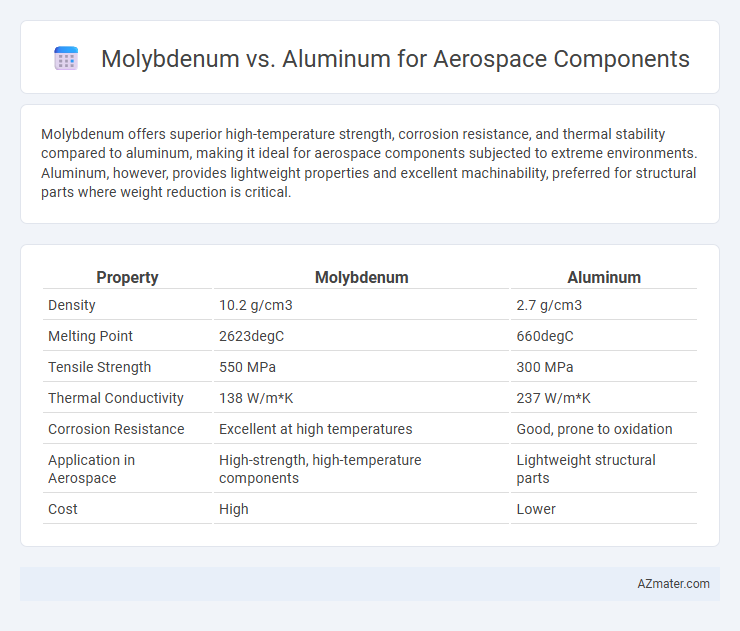Molybdenum offers superior high-temperature strength, corrosion resistance, and thermal stability compared to aluminum, making it ideal for aerospace components subjected to extreme environments. Aluminum, however, provides lightweight properties and excellent machinability, preferred for structural parts where weight reduction is critical.
Table of Comparison
| Property | Molybdenum | Aluminum |
|---|---|---|
| Density | 10.2 g/cm3 | 2.7 g/cm3 |
| Melting Point | 2623degC | 660degC |
| Tensile Strength | 550 MPa | 300 MPa |
| Thermal Conductivity | 138 W/m*K | 237 W/m*K |
| Corrosion Resistance | Excellent at high temperatures | Good, prone to oxidation |
| Application in Aerospace | High-strength, high-temperature components | Lightweight structural parts |
| Cost | High | Lower |
Introduction to Aerospace Materials
Molybdenum offers exceptional high-temperature strength and corrosion resistance, making it ideal for aerospace components subjected to extreme thermal and mechanical stresses. Aluminum provides a lightweight solution with excellent strength-to-weight ratio and corrosion resistance, essential for fuel efficiency and structural integrity in aerospace design. Selecting between molybdenum and aluminum depends on specific application requirements such as temperature tolerance, weight constraints, and mechanical load.
Overview: Molybdenum and Aluminum
Molybdenum is a refractory metal known for its high melting point, exceptional strength at elevated temperatures, and excellent corrosion resistance, making it ideal for aerospace components exposed to extreme heat and stress. Aluminum, a lightweight metal with good strength-to-weight ratio, corrosion resistance, and ease of fabrication, is widely used in aerospace for structural parts where weight savings are critical. The choice between molybdenum and aluminum depends on application requirements such as thermal stability, mechanical strength, and weight constraints.
Physical Properties Comparison
Molybdenum exhibits a higher melting point of 2,623degC and superior tensile strength around 550 MPa compared to aluminum's melting point of 660degC and tensile strength near 310 MPa, making it more suitable for high-temperature aerospace applications. Aluminum's density of approximately 2.7 g/cm3 is significantly lower than molybdenum's 10.28 g/cm3, providing advantages in weight-sensitive aerospace components. Thermal conductivity is higher in aluminum at about 237 W/m*K, whereas molybdenum offers better thermal expansion stability with a coefficient around 4.8 um/m*K, crucial for precision aerospace parts under thermal stress.
Mechanical Strength and Durability
Molybdenum exhibits superior mechanical strength and high-temperature durability compared to aluminum, making it ideal for aerospace components subjected to extreme thermal and mechanical stresses. Aluminum offers a lightweight solution with good strength-to-weight ratio, but it lacks the high melting point and creep resistance that molybdenum provides in critical aerospace applications. The exceptional tensile strength and corrosion resistance of molybdenum enhance component longevity under harsh aerospace operational environments.
Thermal Resistance and Conductivity
Molybdenum exhibits superior thermal resistance with a melting point exceeding 2,600degC, making it ideal for aerospace components exposed to extreme temperatures. Its thermal conductivity, approximately 138 W/m*K, ensures effective heat dissipation unlike aluminum, which, despite higher conductivity around 237 W/m*K, has a melting point below 660degC limiting high-temperature applications. The choice between molybdenum and aluminum depends on the thermal environment, prioritizing molybdenum for high-temperature resistance and aluminum for lightweight heat conduction.
Corrosion Resistance and Longevity
Molybdenum offers superior corrosion resistance in extreme aerospace environments compared to aluminum, making it ideal for components exposed to high temperatures and oxidative conditions. Aluminum, while lightweight and cost-effective, tends to corrode faster in harsh atmospheric and saline conditions, reducing its overall longevity. The enhanced durability of molybdenum significantly extends the lifespan of aerospace components, supporting optimal performance and reduced maintenance costs.
Weight Considerations in Aerospace Design
Molybdenum offers superior strength and high-temperature resistance but has a higher density of 10.28 g/cm3, making it less favorable for weight-sensitive aerospace components compared to aluminum, which has a density of 2.70 g/cm3. Aluminum's lightweight properties significantly reduce overall aircraft weight, enhancing fuel efficiency and performance, while molybdenum is typically reserved for critical areas requiring exceptional durability under thermal stress. Weight considerations in aerospace design prioritize aluminum for structural elements to optimize load-to-weight ratios without compromising component integrity.
Fabrication and Machinability
Molybdenum offers exceptional high-temperature strength and corrosion resistance, making it ideal for aerospace components exposed to extreme conditions, but its high melting point and hardness result in more challenging and expensive fabrication and machining processes. Aluminum is favored in aerospace for its lightweight characteristics and superior machinability, enabling faster and more cost-effective fabrication while maintaining adequate strength for many structural applications. Choosing between molybdenum and aluminum involves balancing the need for high-temperature performance against ease of machining and overall manufacturing efficiency.
Cost and Availability Analysis
Molybdenum offers exceptional high-temperature strength and corrosion resistance but comes with a significantly higher cost and limited availability compared to aluminum, which is abundant and far more cost-effective. Aluminum's lightweight properties and widespread supply make it the preferred choice for large-scale aerospace manufacturing, despite its lower melting point and strength. Cost-efficient aluminum alloys enable extensive use in aircraft structures, while molybdenum is reserved for specialized components where superior thermal performance justifies the expense.
Application Suitability: When to Choose Molybdenum or Aluminum
Molybdenum excels in aerospace components requiring exceptional high-temperature strength and thermal stability, such as engine parts and heat shields, due to its melting point of 2,623degC and superior creep resistance. Aluminum is preferred for structural components and airframes where lightweight and high corrosion resistance are critical, benefiting from its density of 2.7 g/cm3 and excellent machinability. Choosing between molybdenum and aluminum depends on the specific application's thermal load and weight constraints, with molybdenum suited for extreme conditions and aluminum for weight-sensitive, moderate-temperature environments.

Infographic: Molybdenum vs Aluminum for Aerospace Component
 azmater.com
azmater.com